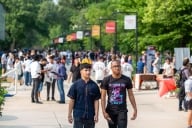You have /5 articles left.
Sign up for a free account or log in.
Some moderately selective colleges seem to reduce financial aid to students who have indicated they might have their heart set on those colleges -- but the practice does not appear widespread, according to a new study of the Free Application for Federal Student Aid, or FAFSA.
“Our main takeaway is that that doesn’t seem to be going on much,” said Stephen R. Porter, a professor of higher education at North Carolina State University. Porter cowrote the new paper, which was prepared for delivery at this week's Association for Education Finance and Policy conference, with Johnathan G. Conzelmann, a researcher at consulting firm RTI International.
The FAFSA is a federal form filled out by most American college students seeking financial aid. When students or their parents fill out the FAFSA, they are asked to submit the names of up to 10 colleges to which they are applying.
That list has turned out to be valuable to college admissions offices and private enrollment management consultants: the order in which students list institutions on the FAFSA corresponds strongly with students’ preferences. Students may be much less interested in attending colleges that they put farther down on the list.
Anecdotally, some colleges may look at this information and use it to make decisions about admission, placement on a wait list or the size of a financial aid award.
The paper tested the theory that colleges charge more to the students most interested in attending the institution, based in part on FAFSA position. One prominent enrollment consulting firm did in 2012 advise Indiana State University, for instance, that it could do so. The university and the consultant said in 2013 that the university was not doing this, however.
Porter and Conzelmann found that, by and large, this practice does not seem to be widespread. They used data from the National Postsecondary Student Aid Study to look at aid packages awarded to 5,257 students who enrolled in a college or university they listed first on the FAFSA. Their study, which looked at a little over 500 public and private colleges, found that “selective colleges and universities do not appear to be lowering their financial aid packages in response to student lists.”
The paper does detect some aid packages reductions, though. Namely, the research indicates that students who enroll in a "moderately selective"if this is his phrase, put in quotes again? and maybe add a sentence saying why this would be likeliest at this kind of college? will be obvious to some, but not all ... dl - Changed/added. Please check my sentence to make sure I got this supposition for why correct - - Ry college they listed first on the FAFSA faced a “5.5 percent penalty in aid.” That means a student who receives a $10,000 scholarship package from a college may have lost out on $500 because he or she put the college first when filling out the FAFSA.
The paper does not say this, but a moderately selective college may be the most likely to use aggressive tactics to enroll students if it is a struggling private fighting for students or a less-known public trying to raise its profile by increasing the number of students with high grades and test scores.
Porter said his main takeaway, though, was that this was not a widespread practice.
The FAFSA form does tell students they may want to list their preferred college first if they are seeking state aid. The form does not, however, warn students about how colleges may use the information. Some criticize the use of the information, which, largely unbeknownst to students, is passed on to all the colleges they are interested in.
And while colleges think students are listing the colleges in order of preference, that may not always be true.
Often enough, students do list their top choice first, the authors found: students are more likely to enroll in the college they listed first. If a student listed three colleges, 56 percent of students enrolled in the first college they listed on the form, 24 percent enrolled in the second and 19 percent enrolled in the college listed last. That aligns closely with what another enrollment consulting firm found when it analyzed FAFSA position for private college clients: 62 percent of students who list a college first on the FAFSA will attend if they are admitted. If they list a college second, 21 percent are likely to enroll if admitted. That drops to about 15 percent if they listed it third and hovers in the 10 percent range for the other seven spots.
Still, the questionable practice of using the FAFSA in certain ways prompted the National Association for College Admission Counseling to last year ask the federal government to stop providing FAFSA position information to colleges.
The current version of the paper, which is likely to be revised, does leave some unanswered questions. Namely, it looks only at aid packages given to students who enroll at the institution they list first. The sample size may be too small to look at aid packages given to students who enrolled in a college they listed farther down the list.








